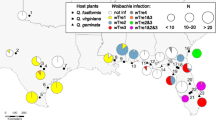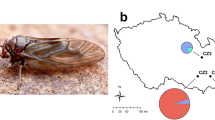Abstract
Phylogenetic studies have implicated frequent horizontal transmission of Wolbachia among arthropod host lineages. However, the ecological routes for such lateral transfer are poorly known. We surveyed the species of two arthropod communities, one on pumpkin and the other on loofah plants, for Wolbachia, constructed wsp gene phylogenies of those Wolbachia strains found to infect community members, and established ecological links among infected members. Four taxonomically diverse insects in the pumpkin arthropod community contained very closely related Wolbachia wsp sequences (<1.5% divergence by Kimura-2-parameter distances). These insects, namely, the whitefly Bemisia tabaci, the planthopper Nisia nervosa, the flea beetle Phyllotreta sp., and the fleahopper Halticus minutus, were all collected from pumpkin leaves. They were ecologically linked through feeding on the same leaf substrate. Unlike other infected leaf insects, the whitefly population appeared to have a permanent breeding relationship with pumpkin plants, and high and stable, but not fixed, monthly Wolbachia infection rates. Our findings suggest potential roles for the plant in Wolbachia transmission and for whiteflies in being an infection source for other pumpkin leaf-feeding insects.


Similar content being viewed by others
References
Bordenstein, SR, Wernegreen, JJ (2004) Bacteriophage flux in endosymbionts (Wolbachia): infection frequency, lateral transfer, and recombination rates. Mol Biol Evol 21: 1981–1991
Cook, J, Butcher, R (1999) The transmission and effects of Wolbachia bacteria in parasitoids. Res Pop Ecol 41: 15–28
Cordaux, R, Michel-Salzat, A, Bouchon, D (2001) Wolbachia infection in crustaceans: novel hosts and potential routes for horizontal transmission. J Evol Biol 14: 237–243
Dobson, SL, Bourtzis, K, Braig, HR, Jones, BF, Zhou, WG, Rousset, F, O’Neill, SL (1999) Wolbachia infections are distributed throughout insect somatic and germ line tissues. Insect Biochem Mol Biol 29: 153–160
Gray, SM, Banerjee, N (1999) Mechanisms of arthropod transmission of plant and animal viruses. Microbiol Mol Biol Rev 63: 128–148
Heath, BD, Butcher, RDJ, Whitfield, WGF, Hubbard, SF (1999) Horizontal transfer of Wolbachia between phylogenetically distant insect species by a naturally occurring mechanism. Curr Biol 9: 313–316
Holden, PR, Brookfield, JFY, Jones, P (1993) Cloning and characterization of an ftsZ homologue from a bacterial symbiont of Drosophila melanogaster. Mol Genet 240: 213–220
Huigens, ME, de Almeida, RP, Boons, PAH, Luck, RF, Stouthamer, R (2004) Natural interspecific and intraspecific horizontal transfer of parthenogenesis-inducing Wolbachia in Trichogramma wasps. Proc R Soc Lond B 271: 509–515
Hurst, GDD, Hurst, LD, Majerus, MEN (1992) Selfish genes move sideways. Nature 356: 659–660
Jiggins, FM, Schulenburg, JHGvd, Hurst, GDD, Majerus, MEN (2001) Recombination confounds interpretations of Wolbachia evolution. Proc R Soc Lond B 268: 1423–1427
Kittayapong, P, Jamnongluk, W, Thipaksorn, A, Milne, JR, Sindhusake, C (2003) Wolbachia infection complexity among insects in the tropical rice-field community. Mol Ecol 12: 1049–1060
Malloch, G, Fenton, B (2005) Super-infections of Wolbachia in byturid beetles and evidence for genetic transfer between A and B super-groups of Wolbachia. Mol Ecol 14: 627–637
Miles, PW (1968) Insect secretions in plants. AnnuRevPhytopathol 6: 137–164
Mitsuhashi, W, Saiki, T, Wei, W, Kawakita, H, Sato, M (2002) Two novel strains of Wolbachia coexisting in both species of mulberry leafhoppers. Insect Mol Biol 11: 577–584
Noda, H, Miyoshi, T, Zhang, Q, Watanabe, K, Deng, K, Hoshizaki, S (2001) Wolbachia infection shared among planthoppers (Homoptera : Delphacidae) and their endoparasite (Strepsiptera : Elenchidae): a probable case of interspecies transmission. Mol Ecol 10: 2101–2106
O’Neill, SL, Giordano, R, Colbert, AME, Karr, TL, Robertson, HM (1992) 16S rRNA phylogenetic analysis of the bacterial endosymbionts associated with cytoplasmic incompatibility in insects. Proc Natl Acad Sci USA 89: 2699–2702
Posada, D, Crandall, KA (1998) Modeltest: testing the model of DNA substitution. Bioinformatics 14: 817–818
Purcell, AH (1985) The ecology of bacterial and mycoplasma plant diseases spread by leafhoppers and planthoppers. In: Nault, LR, Rodriquez, JG (Eds.) The Leafhoppers and Planthoppers. Wiley, NY, pp 351–380
Rigaud, T, Juchault, P (1995) Success and failure of horizontal transfers of feminizing Wolbachia endosymbionts in woodlice. J Evol Biol 8: 249–255
Sambrook, J, Fritsch, EF, Maniatis, T (1989) Molecular Cloning: A Laboratory Manual. Cold Spring Harbor Laboratory Press, Cold Spring Harbor, NY
Sanger, F (1988) Sequences, sequences and sequences. Annu Rev Biochem 57: 1–28
Schilthuizen, M, Stouthamer, R (1997) Horizontal transmission of parthenogenesis-inducing microbes in Trichogramma wasps. Proc R Soc Lond B 264: 361–366
Stevens, L, Giordano, R, Fialho, RF (2001) Male-killing, nematode infections, bacteriophage infection, and virulence of cytoplasmic bacteria in the genus Wolbachia. Ann Rev Ecol Syst 32: 519–545
touthamer, R, Breeuwer, JAJ, Hurst, GDD (1999) Wolbachia pipientis: microbial manipulator of arthropod reproduction. Annu Rev Microbiol 53: 71–102
Swofford, DL (1999) PAUP: Phylogenetic Analysis Using Parsimony. Centre for Agriculture and Bioscience International, Champaign, IL
Van Meer, MMM, Witteveldt, J, Stouthamer, R (1999) Phylogeny of the arthropod endosymbiont Wolbachia based on the wsp gene. Insect Mol Biol 8: 399–408
Vavre, F, Fleury, F, Lepetit, D, Fouillet, P, Bouletreau, M (1999) Phylogenetic evidence for horizontal transmission of Wolbachia in host–parasitoid associations. Mol Biol Evol 16: 1711–1723
Werren, JH, Zhang, W, Guo, LR (1995) Evolution and phylogeny of Wolbachia-reproductive parasites of arthropods. Proc R Soc Lond B 261: 55–63
Werren, JH (1997) Biology of Wolbachia. Annu Rev Entomol 42: 587–609
Werren, JH, O’Neill, SL (1997) The evolution of heritable symbionts. In: O’Neill, SL, Hoffmann, AA, Werren, JH (Eds.) Influential Passengers. Inherited Microorganisms and Arthropod Reproduction. Oxford, New York, pp 1–42
Werren, JH, Bartos, JD (2001) Recombination in Wolbachia. Curr Biol 11: 431–435
Zhou, W, Rousset, F, O’Neill, SL (1998) Phylogeny and PCR-based classification of Wolbachia strains using wsp gene sequences. Proc R Soc Lond B 265: 509–515
Acknowledgments
We are grateful to Sanwapan Sanpittaya for cultivating pumpkin and loofah plants, Wanwisa Jamnongluk for phylogenetic analysis advice, Samnieng Theinthong and Nutchaya Klinpikul for technical assistance, Vichit Koonthong for insect and Sangvorn Kitthawee for parasitoid identification, Paul DeBarro for whitefly molecular identification, and Amporn Duangkaew for administrative support. This research was financed by the TRF/BIOTEC Special Program for Biodiversity Research and Training (BRT139026) and the Thailand Research Fund (RTA428001).
Author information
Authors and Affiliations
Corresponding author
Rights and permissions
About this article
Cite this article
Sintupachee, S., Milne, J.R., Poonchaisri, S. et al. Closely Related Wolbachia Strains within the Pumpkin Arthropod Community and the Potential for Horizontal Transmission via the Plant. Microb Ecol 51, 294–301 (2006). https://doi.org/10.1007/s00248-006-9036-x
Received:
Accepted:
Published:
Issue Date:
DOI: https://doi.org/10.1007/s00248-006-9036-x




